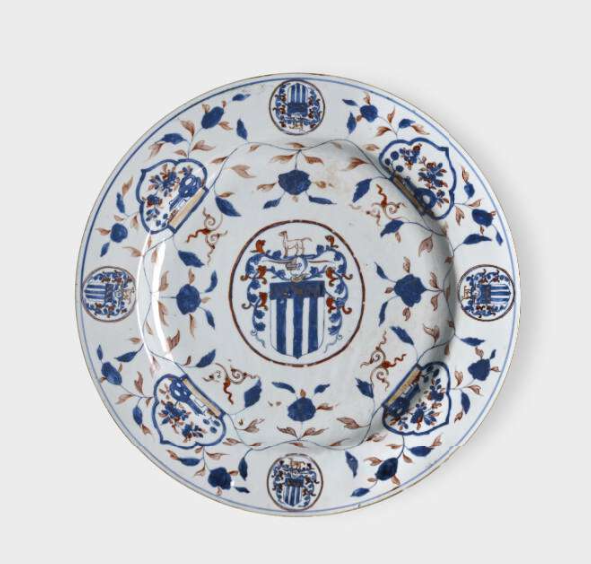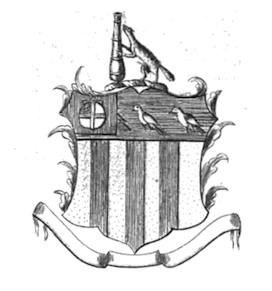2024-4-9
大英博物館裡珍藏的一個康熙朝景德鎮仿日本伊萬里釉下青花釉上礬紅和描金外銷瓷盤:
Chinese imari plate with an English coat of arms. The large plate is decorated in Chinese imari style, in underglaze blue, red enamel and gilding, with a central medallion containing a coat of arms with elaborate fronds surmounted by a helmet and with an animal crest; this medallion is repeated four times on the rim, alternating with ruyi - shaped panels enclosing small landscape scenes, which are joined by an overall flower scroll. The base shows a lingzhi mark in a double circle. The arms are Martin. This is one of the Martin families of Worcestershire and London.


|  |  |
這是一個徽章瓷,傳承有序,當初是為東印度公司的船長馬修馬丁(1676-1749)家族特別定製的。

Black and white print of Matthew Martin’s portrait 1712
The animal which forms the crest of this coat of arms is believed to represent a marten, a homophone of the name Martin, the family to whom the coat of arms belongs. This dish as well as a covered jug (Howard, 1974, p. 176) formed part of a service made for Matthew Martin, Captain of the East Indiaman Marlborough, a ship known to have been at Canton in 1716; he later became a director of the East India Company.
This dish shows how in the Kangxi period standard export porcelain styles were adapted to fit a Western coat of arms harmoniously into a Chinese design. Various similar plates and dishes with floral motifs instead of the arms were exported to the Middle East and are preserved in the Topkapi Saray Museum, Istanbul, Turkey (Krahl, 1986, vol. III, nos. 2994-8). The same design was used again for another armorial service, made around the same time for Daniel Horsemonden of New York, a relative of whom was also involved in the China trade and is known to have been in Canton in 1721 (Howard, 1974, p. 176. For a Chinese imari coffee-pot with the same armorial; Sargent, 1993, p. 208 and pl. 2).
|
美國大都會博物館裡,也展覽了一個景德鎮專門為歐洲市場生產的清雍正時期(1725-1730)仿日本伊萬里風格的瓷盤:
The extensive use of gilding and the dark blue and red enamels illustrate the Chinese adoption of the Japanese Imari style. This style became popular in Europe in the mid-seventeenth century, when warfare in China disrupted the kilns at Jingdezhen. Once work there resumed, Chinese potters incorporated the Imari style in their repertory in order to appeal to the lucrative European market.
歷史上日本人學中國,中國人也學日本,本屬正常的文化交流,尤其是近代。可不知為什麼,眼下的中國人,大都一葉障目,不願意承認這一點。
|












